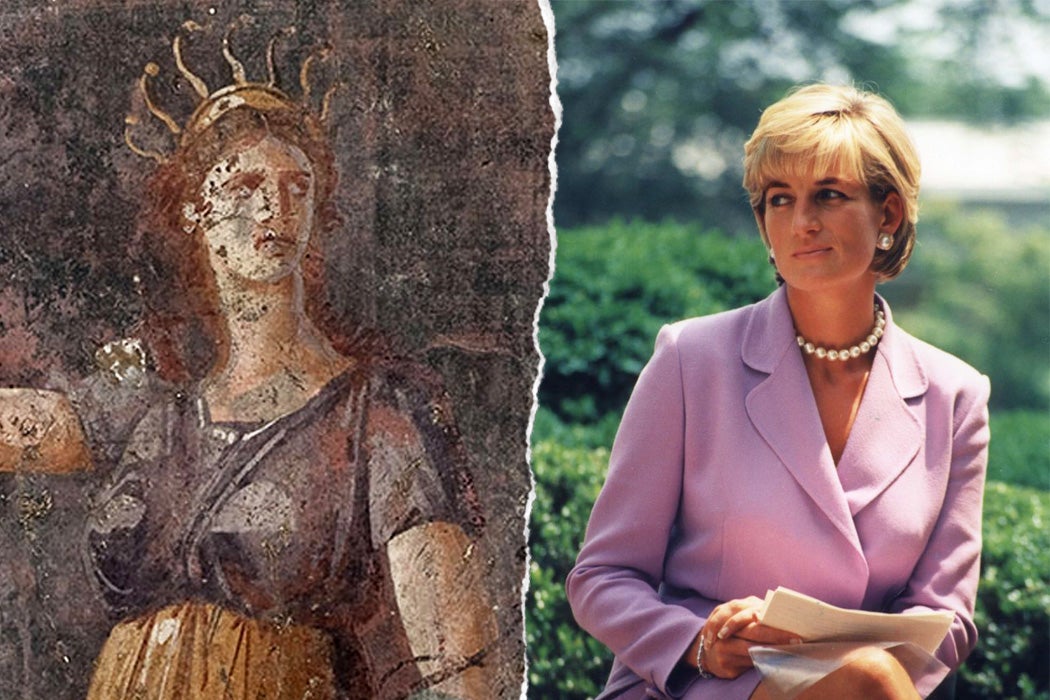Twenty-five years after her untimely death, the legacy of Diana, Princess of Wales—more commonly known as Princess Diana—endures. For gender and cultural studies scholar Jane Caputi, who considered Diana’s iconic status in the years immediately following her death, the former royal’s image draws its power and longevity from mythology, specifically the parallels between the narratives of Diana, the goddess, and the life of Diana Spencer, the woman. Princess Diana’s popularity and power was “based in infinite background layers of older tales that infuse the surface narrative with memory, color, nuance, soul, and meta-morphic power,” writes Caputi.
The ancient goddess Diana evolved as a “folk” deity, seen as protector of the underclasses—the people’s goddess—a role that the public assigned to Diana Spencer as well. “Values associated with Princess Diana include compassion, love, and recognition of the primacy of the common people,” Caputi notes.
Then-Prime Minister Tony Blair posthumously dubbed Diana the “People’s princess” for her common touch. Rather than serving as an “icon of whiteness, privilege, race and class superiority,” Caputi argues, Diana herself saw her role as advocating for those “rejected by society,” with whom she felt an “affinity”: those diagnosed with AIDS, landmine victims, and homeless youth. Of course, it’s not mutually exclusive. Diana arguably was (and is) a symbol of white privilege and class superiority while simultaneously wielding an empathy that made others feel she was more “of the people” than “of the establishment.”
For those with less favorable opinions of Diana, there was the ancient construct of the Great Bitch (“The multiple teats/breasts of the Ephesian Diana refer to these origins,” explains Caputi). Hecate-Artemis (Diana) was depicted in the Ionian period as a “whelping Bitch,” and the word may have become a slur in Christian Europe because of its association with this destructive, vengeful goddess of wild animals.
Caputi shares the reaction of art historian Simon Schama to an interview with the Princess of Wales that was televised in 1995 as part of the BBC’s docuseries, Panorama. Schama explicitly evokes the mythological Diana in reference to the princess’s persona: “Treat her badly and she’ll treat you to a quiver full of arrows,” he suggests. Drawing on animal imagery, he characterizes Princess Diana as having “turned from desperate molting swan into bird of prey… an exterminating angel.”
“Such hyperbole reflects the threat that Diana posed in manifesting those most denied, feared, and potent aspects of archetypal female sacred power,” writes Caputi.
Weekly Newsletter
Princess Diana’s brother, Charles, has also been instrumental in forging his late sister’s mythology. At her funeral, he emphasized the connection between goddess and princess, describing her as “the hunted, not the huntress.” The mythological was further concretized with the thirty-six oak trees, referencing the oak grove of Diana of Nemi in antiquity, that line the drive to Althorp, her childhood home and site of her burial. Her grave rests on an island, inaccessible to the public. Across from the island, a Doric temple displays Diana’s name and silhouette. Writes Caputi,
Pilgrims visit, bringing flowers, and written and sketched prayers and remembrances to a Diana whom we might recognize as an emerging deity, both ancient and new. Althorp is public only during the months of July and August, opening on the day of her birth and closing the day before her death. August may soon again be heralded as the sacred festival month of the Goddess Diana.
The “mytho-religious” behaviour around celebrity culture—worship and idolatry, ritual sacrifice and scapegoating—can show how mythic traditions are “antecedents of contemporary ideas.” Twenty-five years after an admittedly tragic death, a new kind of celebrity culture fueled by social media, a nostalgic pop culture, and recent tumultuous events in the British royal family have made Diana’s myth pertinent again: Diana as victim, Diana as victor, Diana as guardian angel, Diana as avenging angel. “It is myth, archetype, and icon that enable the expression of otherwise remote or ineffable concepts and emotions,” offers Caputi. The endurance of the myth of Diana perhaps also demonstrates how we still struggle to make sense of her life and death, and our reactions to both.







